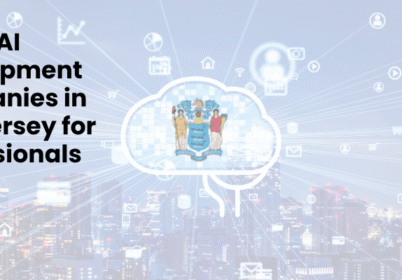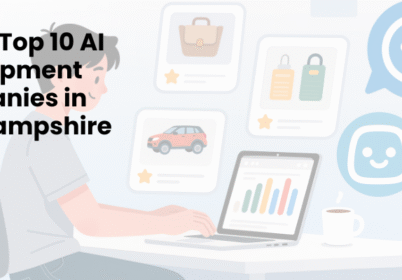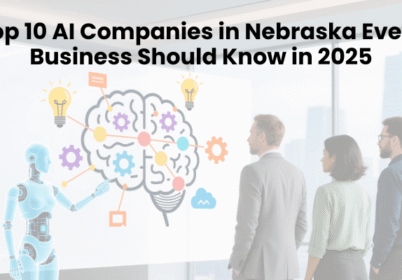How Much Does E-Learning App Development Cost?

Table of Contents
Are you considering developing an e-learning app but feeling uncertain about the financial investment required? Understanding development costs does not need to become an overwhelming challenge that prevents you from moving forward. Picture this scenario: you have developed an innovative educational concept that could revolutionize learning experiences for thousands of users.
The global e-learning market is experiencing unprecedented growth in 2025, creating exceptional opportunities for entrepreneurs like yourself. Digital learning platforms are becoming essential tools as more people seek flexible, accessible education solutions that fit their busy lifestyles.
This comprehensive guide will provide you with clear insights into development costs, budgeting strategies, and practical approaches to building successful educational platforms. You will discover different types of e-learning applications, understand cost breakdowns, explore essential features, and learn about technology choices that impact your investment decisions.
主要ポイント
- Understand how e-learning app development costs vary from $25,000 to $500,000 based on complexity, features, and region.
- Learn the major cost components, including planning, design, backend development, testing, and long-term maintenance.
- Discover smart cost-saving strategies like building an MVP, using open-source tools, and outsourcing to skilled global teams.
- Identify the essential features—user dashboards, course management, video streaming, quizzes, and AI recommendations—that drive engagement.
- Explore top technology stacks such as React, Flutter, Node.js, and AWS for scalable and budget-friendly solutions.
- Build a successful, future-ready e-learning platform through strategic planning, quality partnerships, and continuous user-focused improvements.
Table of Contents
Understanding E-Learning Apps
Have you ever considered what distinguishes e-learning apps from traditional educational tools you encounter in your daily learning experiences? When you seek new knowledge or skills, you likely expect instant access to engaging, interactive content through your mobile device.
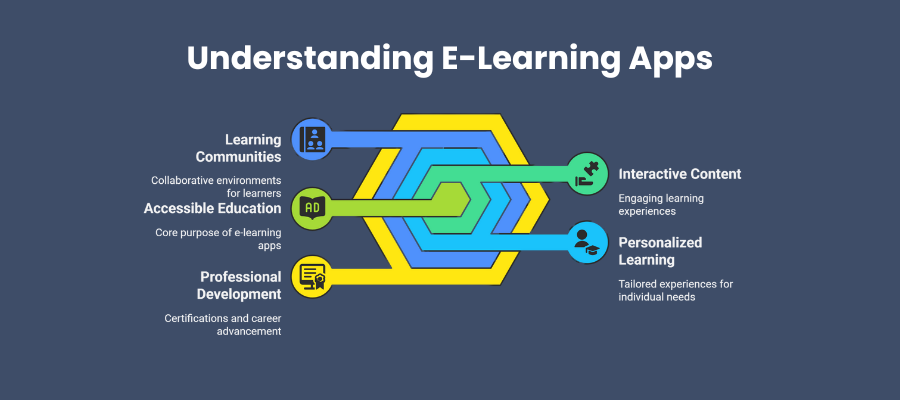
E-learning apps are specialized digital platforms designed to deliver educational content through smartphones, tablets, and computers effectively. These applications serve a fundamental purpose: making education more accessible, interactive, and personalized for learners across different backgrounds and skill levels.
What makes these platforms truly powerful is their ability to adapt to your unique learning preferences and pace. Whether you prefer visual demonstrations, audio explanations, or interactive exercises, modern e-learning applications can customize experiences to match your individual needs.
These apps extend far beyond simple content delivery systems. They create vibrant learning communities where you can interact with fellow students, monitor your progress, receive personalized feedback, and earn valuable certifications that advance your professional development.
Types of E-Learning Apps
Which type of e-learning app aligns best with your vision and available budget for development? Your category selection significantly influences overall development costs, making this decision crucial for your project planning.
Language learning applications focus on helping users master new languages through interactive lessons, speech recognition technology, and gamified learning experiences. These platforms typically require sophisticated artificial intelligence algorithms for pronunciation analysis and personalized learning path creation.
Skill development platforms target professional growth by offering courses in coding, design, marketing, business management, and other career-focused areas. These applications require robust content management systems and comprehensive user progress tracking capabilities to deliver effective learning outcomes.
K-12 learning platforms serve students from kindergarten through high school, requiring age-appropriate interfaces, comprehensive parental controls, and strict curriculum alignment features. These applications often demand the highest security standards to protect young users and comply with educational regulations.
Test preparation apps help students prepare for standardized examinations like SAT, GRE, or professional certification tests effectively. They require extensive question databases, detailed performance analytics, and adaptive testing algorithms that adjust difficulty based on individual performance patterns.
Corporate training applications serve businesses seeking efficient employee education solutions. These platforms need seamless integration capabilities with existing HR systems, detailed reporting features, and comprehensive compliance tracking functionalities.
Virtual classroom solutions enable real-time interaction between instructors and students through advanced communication technologies. They require video conferencing capabilities, screen sharing functionality, interactive whiteboards, and robust infrastructure to handle multiple simultaneous users.
How Much Does it Cost to Develop an E-learning Platform?
What will your e-learning app actually cost to develop from initial concept to final launch? Development costs vary dramatically based on several factors that directly relate to your specific requirements and project scope.
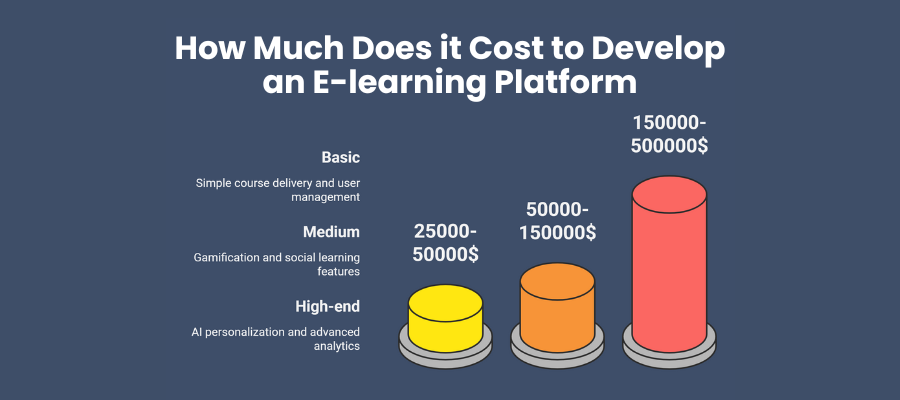
Basic e-learning apps with fundamental features typically range from $25,000 to $50,000 for complete development. These include simple course delivery systems, basic user management capabilities, and standard content presentation features that meet essential learning needs.
Medium complexity platforms cost between $50,000 and $150,000 depending on advanced feature requirements and customization levels. These applications include gamification elements, social learning features, detailed analytics dashboards, and comprehensive mobile optimization for various devices.
High-end enterprise-level platforms can cost $150,000 to $500,000 or more depending on specialized requirements and custom development work. These comprehensive solutions include AI-powered personalization, advanced analytics systems, extensive third-party integrations, and industry-specific customizations.
Your geographical location for development teams significantly impacts total project costs. North American developers typically charge $100-200 per hour, while Eastern European teams offer quality development services at $40-80 per hour rates.
Project complexity, team size requirements, development timeline constraints, and specific feature demands all contribute to your final investment amount.
Cost Breakdown of E-learning Platform Development
Where does your development budget actually go during the creation process? Understanding this detailed breakdown helps you allocate resources wisely and identify potential cost-saving opportunities throughout your project.
| Development Stage | Percentage of Total Cost | Typical Duration |
| Planning & Research | 10-15% | 2-4 weeks |
| UI/UX Design | 15-20% | 4-6 weeks |
| Frontend Development | 25-30% | 8-12 weeks |
| Backend Development | 25-35% | 10-14 weeks |
| Testing & QA | 10-15% | 3-5 weeks |
| Deployment & Launch | 5-10% | 1-2 weeks |
Planning and research phases involve understanding your target audience, defining essential features, and creating comprehensive technical specifications. While representing smaller cost percentages, thorough planning prevents expensive changes during later development stages.
UI/UX design creates the visual interface and user experience that determines whether learners will actively engage with your platform. Quality design work requires experienced professionals who understand educational psychology and effective user behavior patterns.
Frontend development transforms your designs into interactive elements that users see and interact with daily. This includes responsive design for different devices, interactive components, and smooth user interface functionality across various platforms.
Backend development builds the server infrastructure, databases, and APIs that power your application behind the scenes. This crucial work handles user management, content delivery, progress tracking, and complex logic that makes your app function properly.
Testing and quality assurance ensure your platform works flawlessly across different devices, browsers, and usage scenarios effectively.
Additional Cost Factors To Consider
Are you aware of hidden expenses that can significantly impact your total development investment? These often-overlooked costs can add 30-50% to your initial budget without proper planning and consideration.
Cloud hosting and infrastructure costs vary based on your user base size and total content volume requirements. Expect monthly expenses ranging from $500 to $5,000 depending on your platform scale and traffic patterns.
Third-party API integrations for payment processing, video streaming, analytics tools, and social features typically cost $50-500 per month per service. These tools save development time but create ongoing operational expenses that accumulate over time.
Compliance with educational standards like SCORM, xAPI, or accessibility guidelines requires specialized knowledge and additional development work. Budget an extra 15-25% for comprehensive compliance requirements and ongoing maintenance.
Content creation often represents the largest ongoing expense for successful e-learning platforms. Professional course development can cost $10,000-50,000 per hour of finished content, depending on complexity and production quality standards.
Maintenance and updates typically cost 15-20% of your initial development investment annually for optimal platform performance.
How to Reduce the Development Cost of an Educational App?
Are you concerned about whether you can afford to build your ideal e-learning platform? Here are proven strategies that can significantly reduce development costs without compromising quality or essential functionality.
| Cost Reduction Strategy | Potential Savings | Implementation Difficulty |
| Start with MVP | 40-60% | Low |
| Use Open-Source Tools | 20-30% | Medium |
| Offshore Development | 50-70% | Medium |
| Pre-built Modules | 30-40% | Low |
| Phased Development | 30-50% | Low |
| Template-Based Design | 25-35% | Low |
Starting with a Minimum Viable Product allows you to test your concept with essential features only. You can validate your idea, gather valuable user feedback, and secure additional funding before investing in advanced functionality.
Leveraging open-source tools and frameworks eliminates expensive licensing costs and reduces overall development time significantly. Popular options include Moodle for learning management, React for frontend development, and Node.js for backend services.
Outsourcing to cost-effective regions like Eastern Europe, India, or Southeast Asia can reduce development costs by 50-70% while maintaining quality. Research development teams carefully and establish clear communication protocols for successful collaboration.
Using pre-built modules for common features like user authentication, payment processing, and video streaming saves significant development time and money. Focus your custom development budget on unique features that differentiate your platform from competitors.
Phased development spreads costs over extended time periods while generating revenue from early platform versions. Launch with core features, then reinvest profits into additional functionality based on actual user demand patterns.
Top E-Learning Mobile Applications
What makes successful e-learning apps stand out in today’s competitive marketplace? Studying these leading platforms provides valuable insights for your own development strategy and feature prioritization decisions.
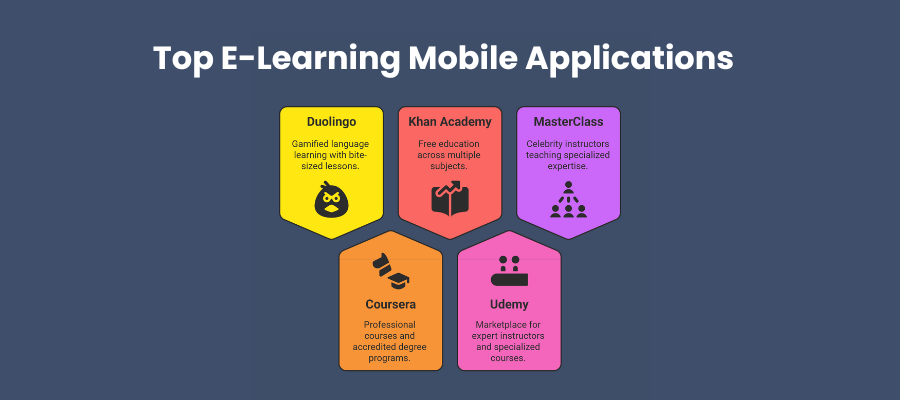
Duolingo revolutionized language learning through innovative gamification techniques and bite-sized lesson formats that keep learners engaged. Their success stems from making learning addictive through streaks, achievements, and social competition elements that encourage daily usage.
Coursera partners with prestigious universities and leading companies to offer professional courses and accredited degree programs. Their platform succeeds by providing credible certifications that genuinely advance careers, justifying premium pricing for high-quality educational content.
Khan Academy offers completely free education across multiple subjects, funded through donations and strategic educational partnerships. Their success demonstrates how quality content and universal accessibility can build massive user bases without direct monetization.
Udemy operates as a comprehensive marketplace where expert instructors create and sell specialized courses to global audiences. This model reduces content creation costs while providing diverse learning options that appeal to various interests and skill levels.
MasterClass focuses on celebrity instructors teaching their specialized expertise through premium video course formats. They prove that high-quality production values and exclusive content can command premium pricing in competitive e-learning markets.
Key Features in E-Learning Solutions
What features should you prioritize to create engaging learning experiences that encourage users to return regularly? Your feature selection directly impacts both development costs and long-term user satisfaction with your platform.
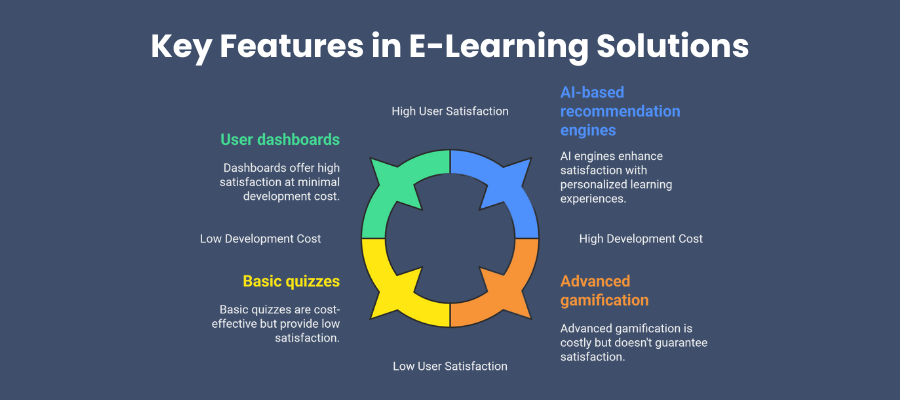
User dashboards provide personalized learning spaces where students track progress, access courses, and manage their complete educational journey. Effective dashboards display relevant information clearly while avoiding overwhelming complexity that confuses new users.
Course management systems enable instructors to create, organize, and deliver educational content efficiently through intuitive interfaces. These tools should support various content types including videos, documents, quizzes, and interactive elements seamlessly.
Video streaming capabilities form the backbone of modern e-learning platforms that deliver engaging multimedia content. Implement adaptive streaming, offline downloads, and playback speed controls to enhance user experience across different network conditions.
Quizzes and assessment tools help measure learning progress accurately while reinforcing key concepts through interactive testing. Include various question types, automated grading systems, and detailed feedback mechanisms to maximize educational value.
Gamification elements like points, badges, leaderboards, and achievements increase engagement and motivation among learners significantly. However, implement these features thoughtfully to enhance rather than distract from primary learning objectives.
AI-based recommendation engines suggest relevant courses and content based on individual user behavior patterns and stated preferences. These systems improve over time, providing increasingly personalized learning experiences that keep users engaged.
Progress tracking shows learners how they are advancing toward their educational goals while providing instructors with valuable insights. Social learning features enable peer interaction through discussion forums, study groups, and collaborative projects effectively.
Technology Stacks for an E-Learning App
Which technologies will best support your e-learning platform while keeping development costs reasonable and manageable? Your technology choices significantly impact both initial development expenses and long-term maintenance costs over time.
Frontend technologies create the user interface and overall experience that learners interact with daily. React and Vue.js offer excellent performance and developer productivity for web applications, while React Native and Flutter enable cost-effective mobile app development.
Backend frameworks handle server-side logic, user management systems, and complex data processing requirements efficiently. Node.js provides excellent performance for real-time features like live classes, while Python with Django offers rapid development capabilities.
Database selection depends on your specific data structure requirements and expected scalability needs over time. PostgreSQL handles complex relational data efficiently, while MongoDB works well for flexible content structures that change frequently.
Cloud platforms like AWS, Google Cloud, or Microsoft Azure offer scalable infrastructure without requiring upfront hardware investments. These services provide pay-as-you-grow pricing models that align operational costs with your actual user base growth.
AI and machine learning integrations enhance personalization capabilities and automation features that improve user experiences. TensorFlow and PyTorch enable custom AI development, while cloud services provide ready-to-use machine learning capabilities.
Video streaming solutions require specialized infrastructure to handle large file sizes and concurrent users effectively. Services like Vimeo, Wistia, or AWS CloudFront handle video delivery efficiently while providing detailed analytics and security features.
| Technology Category | Recommended Options | Cost Impact |
| Frontend Framework | React, Vue.js | Medium |
| Mobile Development | React Native, Flutter | Low |
| Backend Framework | Node.js, Django, Laravel | Medium |
| Database | PostgreSQL, MongoDB | Low |
| Cloud Hosting | AWS, Google Cloud | Variable |
| Video Streaming | Vimeo, AWS CloudFront | High |
Start Growing Your Business With Us
Are you ready to transform your e-learning vision into reality while managing costs effectively throughout the development process? At Shadhin Lab, we understand that developing an educational platform represents a significant investment in your future success.
Our experienced development team specializes in creating cost-effective, scalable e-learning solutions that deliver exceptional user experiences. We work closely with you to understand your specific requirements, target audience characteristics, and budget constraints before recommending optimal approaches.
We offer flexible engagement models including fixed-price projects, dedicated development teams, and hourly consulting services for different needs. This flexibility allows you to choose the approach that best fits your budget and timeline requirements.
Our development process emphasizes transparency and clear communication throughout every project phase. You receive regular progress updates, can track development through our project management tools, and participate in key decisions.
Contact us today to discuss your e-learning project and receive a detailed cost estimate tailored to your requirements.
Final Thoughts
You now possess comprehensive understanding of e-learning app development costs and the various factors that influence your investment decisions. Success lies in balancing your educational vision with realistic budget planning while focusing on features that truly matter.
Remember that developing an e-learning platform extends beyond initial development costs. Consider long-term expenses including maintenance, content creation, marketing efforts, and scaling infrastructure as your user base grows over time.
Your choice of development partner significantly impacts both costs and final outcomes. Look for teams with educational technology experience, transparent pricing structures, and strong communication skills that align with your project needs.
Start with a clear vision of your target audience and their specific learning requirements. This focus helps prioritize essential features and allocate your budget effectively while building a foundation for future growth.
The e-learning market continues expanding rapidly, creating exceptional opportunities for innovative platforms that solve real educational challenges. With proper planning and execution, your platform can make meaningful impact while generating sustainable returns on investment.
Frequently Asked Questions
What is the average cost to develop a basic e-learning app?
You can expect to invest between $25,000 to $50,000 for a basic e-learning app with essential features like course delivery, user management, and simple content presentation. This cost varies based on your chosen development team location and specific requirements.
How long does it take to develop an e-learning platform?
Development timelines typically range from 4 to 8 months for medium complexity platforms. Your timeline depends on feature complexity, team size, and how quickly you can provide feedback during the development process.
Should I choose native or cross-platform development for my e-learning app?
Cross-platform development using React Native or Flutter often provides the best value for e-learning apps. You can reach both iOS and Android users while reducing development costs by 30-40% compared to building separate native apps.
What ongoing costs should I budget for after launching my e-learning app?
Plan for annual maintenance costs of 15-20% of your initial development investment. Additional ongoing expenses include hosting, third-party services, content updates, and marketing costs that scale with your user base growth.
How can I validate my e-learning app idea before investing in full development?
Start by creating a detailed business plan and conducting market research with your target audience. Consider building a simple landing page to gauge interest, or develop a basic prototype to test core concepts before major investment.
Shaif Azad
Related Post
Top 10 AI Development Companies in New Jersey for Business
Are you searching for the perfect AI development partner in New Jersey? Have you wondered which...
Top 10 AI Development Companies in New Hampshire
Are you watching New Hampshire’s tech landscape transform before your eyes? Your state is quietly becoming...
Top AI Companies in Nebraska Every Business Should Know
Are you a Nebraska business owner wondering how artificial intelligence could transform your operations? Picture this...

